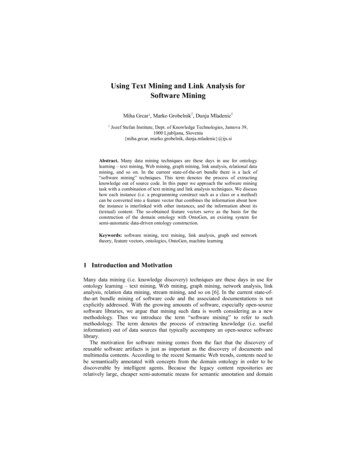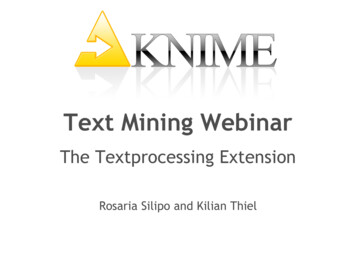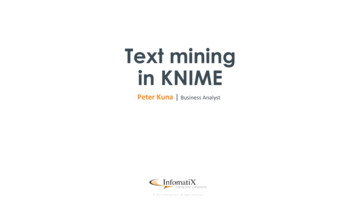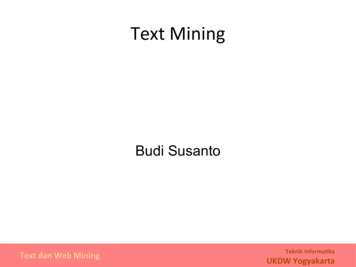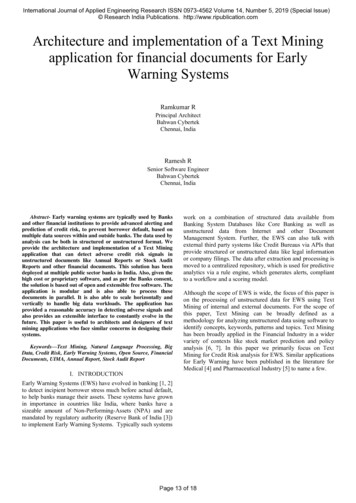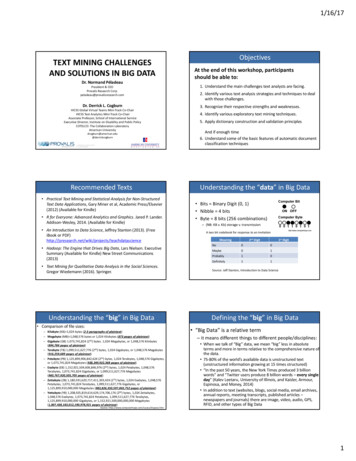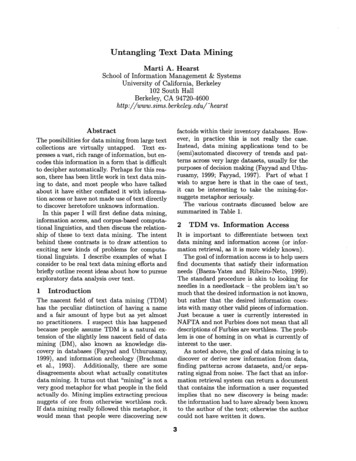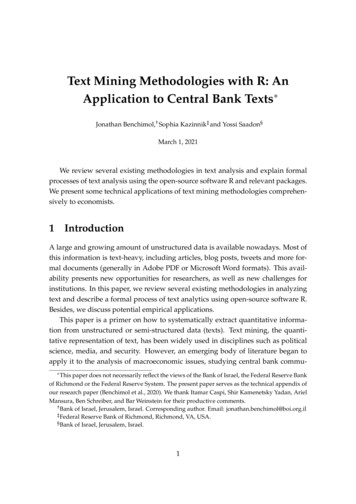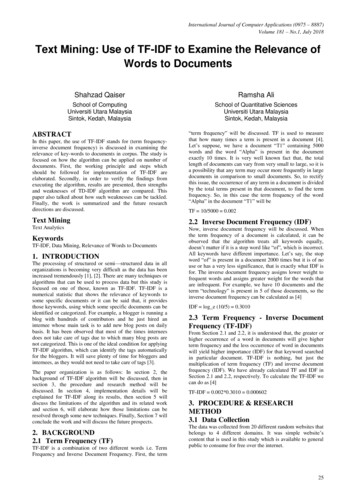
Transcription
International Journal of Computer Applications (0975 – 8887)Volume 181 – No.1, July 2018Text Mining: Use of TF-IDF to Examine the Relevance ofWords to DocumentsShahzad QaiserRamsha AliSchool of ComputingUniversiti Utara MalaysiaSintok, Kedah, MalaysiaSchool of Quantitative SciencesUniversiti Utara MalaysiaSintok, Kedah, MalaysiaABSTRACTIn this paper, the use of TF-IDF stands for (term frequencyinverse document frequency) is discussed in examining therelevance of key-words to documents in corpus. The study isfocused on how the algorithm can be applied on number ofdocuments. First, the working principle and steps whichshould be followed for implementation of TF-IDF areelaborated. Secondly, in order to verify the findings fromexecuting the algorithm, results are presented, then strengthsand weaknesses of TD-IDF algorithm are compared. Thispaper also talked about how such weaknesses can be tackled.Finally, the work is summarized and the future researchdirections are discussed.Text MiningText AnalyticsKeywordsTF-IDF, Data Mining, Relevance of Words to Documents1. INTRODUCTIONThe processing of structured or semi—structured data in allorganizations is becoming very difficult as the data has beenincreased tremendously [1], [2]. There are many techniques oralgorithms that can be used to process data but this study isfocused on one of those, known as TF-IDF. TF-IDF is anumerical statistic that shows the relevance of keywords tosome specific documents or it can be said that, it providesthose keywords, using which some specific documents can beidentified or categorized. For example, a blogger is running ablog with hundreds of contributors and he just hired aninternee whose main task is to add new blog posts on dailybasis. It has been observed that most of the times interneesdoes not take care of tags due to which many blog posts arenot categorized. This is one of the ideal condition for applyingTF-IDF algorithm, which can identify the tags automaticallyfor the bloggers. It will save plenty of time for bloggers andinternees, as they would not need to take care of tags [3].The paper organization is as follows: In section 2, thebackground of TF-IDF algorithm will be discussed, then insection 3, the procedure and research method will bediscussed. In section 4, implementation details will beexplained for TF-IDF along its results, then section 5 willdiscuss the limitations of the algorithm and its related workand section 6, will elaborate how those limitations can beresolved through some new techniques. Finally, Section 7 willconclude the work and will discuss the future prospects.2. BACKGROUND2.1 Term Frequency (TF)TF-IDF is a combination of two different words i.e. TermFrequency and Inverse Document Frequency. First, the term“term frequency” will be discussed. TF is used to measurethat how many times a term is present in a document [4].Let’s suppose, we have a document “T1” containing 5000words and the word “Alpha” is present in the documentexactly 10 times. It is very well known fact that, the totallength of documents can vary from very small to large, so it isa possibility that any term may occur more frequently in largedocuments in comparison to small documents. So, to rectifythis issue, the occurrence of any term in a document is dividedby the total terms present in that document, to find the termfrequency. So, in this case the term frequency of the word“Alpha” in the document “T1” will beTF 10/5000 0.0022.2 Inverse Document Frequency (IDF)Now, inverse document frequency will be discussed. Whenthe term frequency of a document is calculated, it can beobserved that the algorithm treats all keywords equally,doesn’t matter if it is a stop word like “of”, which is incorrect.All keywords have different importance. Let’s say, the stopword “of” is present in a document 2000 times but it is of nouse or has a very less significance, that is exactly what IDF isfor. The inverse document frequency assigns lower weight tofrequent words and assigns greater weight for the words thatare infrequent. For example, we have 10 documents and theterm “technology” is present in 5 of those documents, so theinverse document frequency can be calculated as [4]IDF log e (10/5) 0.30102.3 Term Frequency - Inverse DocumentFrequency (TF-IDF)From Section 2.1 and 2.2, it is understood that, the greater orhigher occurrence of a word in documents will give higherterm frequency and the less occurrence of word in documentswill yield higher importance (IDF) for that keyword searchedin particular document. TF-IDF is nothing, but just themultiplication of term frequency (TF) and inverse documentfrequency (IDF). We have already calculated TF and IDF inSection 2.1 and 2.2, respectively. To calculate the TF-IDF wecan do as [4]TF-IDF 0.002*0.3010 0.0006023. PROCEDURE & RESEARCHMETHOD3.1 Data CollectionThe data was collected from 20 different random websites thatbelongs to 4 different domains. It was simple website’scontent that is used in this study which is available to generalpublic to consume for free over the internet.25
International Journal of Computer Applications (0975 – 8887)Volume 181 – No.1, July 2018Table 1. Domains & WebsitesNo.DomainsWebsite’s Count1.biz52.com53.edu54.org5Total4203.2 Data PreprocessingData is collected from websites hence collected data containedHTML/CSS which was not useful hence it was completelyremoved first. Secondly, the data also contained many stopwords which is never meaningful or useful in this context asexplained in Section 2.2. Hence in order to filter those stopwords, a list of 500 stop words was used first which filteredthe data and removed all stop words from it [1], [4], [5]. Alarge list of stop words can easily be obtained from manyblogs and websites where it is available for free for generalpublic to consume.3.3 DesignIn this study, there are a few steps that has to be followed inorder to successfully implement the TF-IDF algorithm.First of all, data has to be fetched from websites. Secondly, inpreprocessing phase, one has to look for HTML/CSS and stopwords and remove all of them as they are unnecessary has noimportance in this scenario. Third, one need to count totalnumber of words and their occurrences in all documents.Once these steps are performed, one can apply TermFrequency formula to calculate TF as discussed in Section 2.1[1], [4], [6].After calculating TF, one has to check, if each word is foundin every document or not and has to count total number ofdocuments in hand. Once these steps are completed, one canapply Inverse Document Frequency (IDF) formula tocalculate IDF as discussed in Section 2.2 [4].In the last, after obtaining TF and IDF, one can easilycalculate TF-IDF by applying its formula as described inSection 2.3. The algorithm can be implemented in anyprogramming language of your choice. For this paper, it wasimplemented using PHP for the sake of simplicity [4].The TF-IDF process can be observed using a diagram herewhich is showing all major and minor steps that has to betaken in order to successfully implement the algorithm usingcomputer programming.Fig 1: TF-IDF Process26
International Journal of Computer Applications (0975 – 8887)Volume 181 – No.1, July 2018The Fig 1. Should be followed from top to bottom in order toimplement TF-IDF. The process is quite simple but one reallyneed to take special care on data preprocessing as it is veryimportant in order to achieve accurate results.4. IMPLEMENTATION & DISCUSSIONThe algorithm is implemented in PHP hence it can be used viaa web browser. The interface is very easy to use where a userhas to select document by clicking on browse button. Afterproviding the document, the program will execute all the stepsas mentioned in Fig 1 and will give output as shown below inFig 2. The program gives serial number, word, theiroccurrences, term frequency, inverse document frequency andthe thing that should be noticed here is, one can sort theoutput of algorithm either in ascending order or descendingorder based on their occurrences or their TF-IDF score so thatthe keywords having greater occurrences or greater TF-IDFscore would come on the top in decreasing order or thekeywords having lower occurrences or lower TF-IDF scorewould come on the top in increasing order. That can reallyhelp in analyzing or slicing the data to generate reports orvisualizations.The program can be executed with minimum, a fewmicroseconds time to a few seconds or a minute, dependingon the size of the provided dataset.Finally the TF-IDF on which this study is focused on.Fig 2: TF-IDF Program interface after providing a dummy documentsTable 2. Results by running algorithm on three documents from each domainKeyword Rank rking.biz.com.edu.orgFig 3: Top keywords as per their TF-IDF Score from 3 documents each for all domains27
International Journal of Computer Applications (0975 – 8887)Volume 181 – No.1, July 2018Table 2. Shows top two keywords according to highest TFFig 3. Shows only the top one keyword from each domain forIDF score for three documents only from each domain. Thethree documents. It can be seen here that, the highest TF-IDFdata is fetched from the PHP program after running it onscore is of the keyword “Years” that belongs to “.edu”dataset collected from all domains as shown in Fig 2. Table 2.domain. The second highest TF-IDF score is of the keywordDepicts the fact that three documents of .biz domain that were“parts” that belongs to “.biz” domain and similarly the thirdselected, the most relevant keywords that can describe thoseposition goes to “Marking” which belongs to “.org” domain.documents are “parts” and “garden”. Similarly, in threeThe algorithm was tested again, this time with all documentsdocuments of .com domain, the top two words arethat belongs to all domains“presidential” and “held”, also in .edu domain the topkeywords are “years” and “Ms”, which shows that thesekeywords can describe those documents and can be used astags to categorize the content. The .org domain also has“Marking” and “Scholarships” keywords for the samepurpose.Table 3. Results Top 12 Keywords from all ig 4: Top keywords as per their TF-IDF Score from all documents for all domainsTable 3. Shows top 12 keywords as per their highest TF-IDFscore achieved from all documents and domains. In Fig 4, itcan be observed that, when content was processed from alldomains such as .biz, .com, .edu and .org, the most importantand relevant keywords are displayed as a result in sorted form,means that, the keywords with highest TF-IDF score is on topand the lowest is at the end. It proves the fact that in TF-IDFalgorithm you get results from most relevant to most28
International Journal of Computer Applications (0975 – 8887)Volume 181 – No.1, July 2018irrelevant keywords [3] which is very important, if one has toanalyze the data or needs to generate tags for specifying thecategory of some document or blog post.5. LIMITATIONS & RELATED WORKThere are some limitations of TF-IDF algorithm that needs tobe addressed. The major constraint of TF-IDF is, thealgorithm cannot identify the words even with a slight changein it’s tense, for example, the algorithm will treat “go” and“goes” as two different independent words, similarly, it willtreat “play” and “playing”, “mark” and “marking”, “year” and“years” as different words. Due to this limitation, when TFIDF algorithm is applied, sometimes it gives some unexpectedresults [7]. Another limitation of TF-IDF is, it cannot checkthe semantic of the text in documents and due to this fact, it isonly useful until lexical level. It is also unable to check theco-occurrences of words. There are many techniques that canbe used to improve the performance and accuracy asdiscussed by [8], such as Decision Trees, Pattern or rule basedclassifiers, SVM classifiers, Neural Network classifiers andBayesian classifiers. Another author [9] has also detecteddefect in standard TF-IDF that it is not effective if the text thatneeds to be classified is not uniform, so the author hasproposed an improved TF-IDF algorithm to deal with thatsituation. Another author [10] has mixed TF-IDF with NaïveBayes for proper classification while considering therelationships between classes.6. SOLUTIONSWith the passage of time, new algorithms are coming up thatresolves some limitations of older algorithms. For example,stemming process can be used to overcome the issues of TFIDF not being able to identify that the “play” and “plays” arebasically the same words [5]. The stemming process isbasically used for conflating different forms of any particularword such as “play” and “plays” or “played” into a single andmore generic representation such as “play”. Secondly, the stopwords can be added as much as possible so that the words thatare not of any value such as “the” or “a” are filtered andremoved before the data processing [5]. This will ensure tosome extent, that you are getting useful words as output.7. CONCLUSIONTF-IDF algorithm is easy to implement and is very powerfulbut one cannot neglect its limitations. In today’s world of bigdata, world requires some new techniques for data processing,before analysis is performed. Many researchers has proposedan improved form of TF-IDF algorithm known as AdaptiveTF-IDF. The proposed algorithm incorporated the hillclimbing for boosting the performance. A variant of TF-IDFhas also been observed that can be applied in cross-languageby using statistical translation. Genetic algorithms have alsobeen put in work to improve the TF-IDF, as the naturalgenetic concepts of cross over, and mutation was appliedprogrammatically, but it did not see the light of sun, as therewas very slight improvement in performance. Search enginegiants like Google has adapted latest algorithms such asPageRank for bringing out the most relevant results when auser place a query. In future research, world is going toIJCATM : www.ijcaonline.orgwitness some new techniques that can overcome thelimitations of TF-IDF, so that the query retrieval can be moreaccurate. TF-IDF can be combined with other techniques suchas Naïve Bayes to get even better results.8. ACKNOWLEDGMENTThe authors wish to thank all the respected professors whohelped during experiment, development and writing phase ofthis paper.9. REFERENCES[1] Bafna, P., Pramod, D., and Vaidya, A. (2016)."Document clustering: TF-IDF approach," InternationalConference on Electrical, Electronics, and OptimizationTechniques (ICEEOT), Chennai, 2016, pp. 61-66[2] Trstenjak, B., Mikac, S., & Donko, D. (2014). “KNNwith TF-IDF based framework for text categorization” InProcedia Engineering. Vol. 69, pp. 1356–1364. ElsevierLtd[3] Gautam, J., & Kumar, E.L. (2013). “An Integrated andImproved Approach to Terms Weighting in TextClassification,” International Journal of ComputerScience Issues, Vol 10, Issue 1, No 1, January 2013[4] Hakim, A. A., Erwin, A., Eng, K. I., Galinium, M., on for news article in Bahasa Indonesia basedon term frequency inverse document frequency (TF-IDF)approach,” 6th International Conference on InformationTechnology and Electrical Engineering: LeveragingResearch and Technology, (ICITEE), 2014[5] Gurusamy, V., & Kannan, S. (2014). “PreprocessingTechniques for Text Mining,” RTRICS, pp. 7-16[6] Nam, S., and Kim, K. (2017). "Monitoring NewlyAdopted Technologies Using Keyword Based Analysisof Cited Patents," IEEE Access, vol. 5, pp. 23086-23091[7] Ramos, J. (2003). “Using TF-IDF to Determine WordRelevance in Document Queries,” Proceedings of theFirst Instructional Conference on Machine Learning, pp.1–4[8] Santhanakumar, M., and Columbus, C.C. (2015).“Various Improved TFIDF Schemes for Term Weighingin text Categorization: A Survey," International Journalof Applied Engineering Research, vol. 10, no. 14, pp.11905-11910[9] Dai, W. (2018). “Improvement and Implementation ofFeature Weighting Algorithm TF-IDF in TextClassification,” International Conference on Network,Communication, Computer Engineering (NCCE 2018),vol. 147[10] Fan, H., and Qin, Y. (2018). “Research on TextClassification Based on Improved TF-IDF Algorithm,”International Conference on Network, Communication,Computer Engineering (NCCE 2018), vol. 14729
Text Mining 2.2 Text Analytics Keywords TF-IDF, Data Mining, Relevance of Words to Documents 1. INTRODUCTION Th
